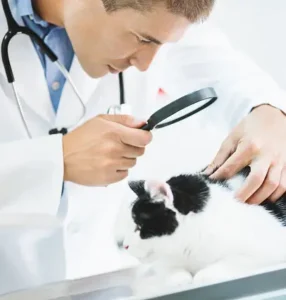Cancer in cats and humans is the uncontrolled growth and division of abnormal cells in the body. It can affect various organs and tissues and lead to various health problems. As in humans, early diagnosis and treatment are essential for a better prognosis. Here are 8 dangerous types of Cancer In Cats :

- Lymphoma: Lymphoma is one of the most common cancers in cats. It affects the lymphatic system, which is part of the immune system. Lymphomas can manifest in different ways and in different places, such as in the digestive tract, in the lymph nodes and on the skin.
- Squamous Cell Carcinoma: This type of cancer commonly affects the mouth (particularly the gums and tongue) and the skin of the ears. It is more common in light-haired cats and may be related to sun exposure.
- Breast tumors: Breast tumors are relatively common in unneutered cats. Sterilization before the first heat reduces the risk of developing these tumors significantly.
- Fibrosarcoma: These tumors arise from fibrous connective tissue and can occur at vaccination sites. This is one of the reasons why veterinarians often recommend rotating vaccination sites in cats.
- Hemangiosarcoma: Hemangiosarcoma is a type of cancer that starts in blood vessels. It can affect different organs and be aggressive.
- Osteosarcoma: This is a bone tumor that usually affects the legs and can be very painful for cats.
- Transitional Cell Carcinoma: This type of cancer affects the bladder and sometimes the urethra. It can cause urinary problems and is more common in older cats.
- Kidney tumors: These tumors can affect the kidneys and lead to kidney dysfunction. Cancer symptoms in cats can vary depending on the type and location of the tumor.
Signs And Symptoms:

- Lumps Or Bumps : Palpable lumps or masses anywhere on the body.
- Behavior changes: loss of appetite, lethargy, or behavior changes.
- Weight Loss: Unexplained weight loss despite eating normally.
- Respiratory Difficulty: Shortness of breath or difficulty breathing.
- Changes in Elimination: Changes in the way you urinate or defecate.
- Mouth problems: Difficulty eating, drooling, or bad breath.
- Skin lesions: non-healing wounds, skin lesions or persistent itching.
If you suspect your cat has cancer, it is important to contact your vet immediately. Diagnosis usually involves a combination of physical examination, imaging (X-ray, ultrasound), and biopsy. Treatment options may include surgery, chemotherapy, radiation, and in some cases palliative care to relieve symptoms and improve your cat’s quality of life.
Do You Know About: 4 Surprising Facts About Feline Leukemia Virus
Transmission Of Cancer In Cats:
Transmission of cancer between cats, known as “horizontal transmission,” is extremely rare. Unlike certain viruses or bacterial infections, cancer is not typically contagious in the same way. Here’s why:

- Origin of Cancer Cells: Cancers arise from mutations in a cat’s own cells. These mutations can lead to uncontrolled cell growth and the development of tumors. Each individual cat’s cancer is a result of its own genetic and environmental factors.
- Immune System: The immune system of a healthy cat is generally capable of recognizing and targeting abnormal cells, including cancer cells. This recognition helps prevent the spread of cancer from one cat to another.
- Immune Rejection: When foreign cells, such as those from another cat, are introduced into a different individual, the immune system often recognizes them as foreign and mounts an immune response to reject them. This immune response would likely prevent the successful transmission of cancer cells between cats.
- Tumor Environment: Cancer cells rely on a specific environment to thrive and grow. This environment is influenced by the genetic makeup of the individual, as well as other factors such as blood supply and hormones. The unique tumor microenvironment in each cat makes it unlikely that cancer cells from one cat would be able to survive and proliferate in a different cat.
- Cancer Cell Fragility: Cancer cells are fragile and are not well-equipped to survive outside of the body. They require specific conditions to grow and divide, which are not typically present in the external environment.
Treatment Of Cancer In Cats:
Treatment for cancer in cats varies depending on the type of cancer, its stage, the cat’s overall health, and other individual factors. Here are some common treatment options for cat cancer:

- Surgery: Surgical removal of the tumor is a common approach when the tumor is localized and can be safely removed. Surgery can cure some types of cancer if the tumor is completely removed. However, it can also be used to remove the tumor as completely as possible before other treatments, such as chemotherapy or radiotherapy.
- Chemotherapy: Chemotherapy uses drugs to specifically kill cancer cells. Chemotherapy can be used to shrink tumors before surgery, prevent or slow metastasis (spread to other parts of the body), or to relieve cancer symptoms and improve your cat’s quality of life.
- Radiation Therapy : Radiation therapy uses high-energy rays to specifically kill cancer cells. It is often used for tumors that are not amenable to surgery or when surgery is not entirely successful. Radiation therapy can also help relieve pain or discomfort caused by tumors.
- Immunotherapy: Immunotherapy is a relatively new approach that aims to increase the ability of the cat’s immune system to recognize and attack cancer cells. This can be done using a variety of methods, such as vaccines or immune checkpoint inhibitors.
- Palliative Care: Palliative care focuses on comfort and symptom relief rather than cancer treatment. This may include pain management, dietary changes, and other supportive measures to improve your cat’s quality of life.
- Targeted therapies: These are drugs that specifically target specific molecules involved in the growth and spread of cancer cells. Targeted therapies can be more selective and have fewer side effects than traditional chemotherapy.
- Clinical Trials: In some cases, cats with cancer may be eligible to participate in clinical trials for new treatments or therapies. These studies can provide access to cutting-edge treatments that may not yet be widely available.
- Combination therapy: Depending on the type and stage of the cancer, a combination of several treatments (surgery, chemotherapy, radiation, etc.) may be recommended to achieve the best result.
May You Like That: 7 Impressive Facts: Feline Immunodeficiency Virus
Prevention Of Cancer In Cats:
While it’s not always possible to completely prevent cancer in cats, there are steps you can take to reduce your risk and improve your overall well-being. Here are some tips for preventing cancer in cats:

- Spaying and Spaying: Spaying females before they are in heat and spaying males when they are young can reduce the risk of some reproductive cancers, such as breast tumors and testicular cancer.
- Healthy diet: Provide your cat with a balanced and nutritious diet. We recommend high quality, commercial cat food that meets your cat’s specific nutritional needs. Ask your veterinarian for dietary recommendations based on your cat’s age, medical condition, and specific nutritional needs.
- Weight Management: Obesity is a risk factor for many health problems, including cancer. Keeping your cat at a healthy weight reduces the risk of obesity-related cancers and other health problems.
- Regular vet check-ups: Arrange regular check-ups with your veterinarian. Regular visits to the vet can help to identify health problems early and to intervene in time.
- Vaccinations: Inform yourself about your cat vaccinations. Vaccines can protect against some viral infections that can increase your risk of cancer, such as feline leukemia virus (FeLV) and feline immunodeficiency virus (FIV).
- Limit Sun Exposure: When your cat spends time outdoors, provide shaded areas and limit exposure to the sun, especially in light-haired cats. This can help reduce the risk of skin cancer.
- Environmental Enrichment: Provide your cat with mental and physical stimulation to reduce stress and support a healthy immune system. Interactive toys, scratching posts, and opportunities to play and explore can contribute to general well-being.
- Reduction of Environmental Toxins: Minimize exposure to potential carcinogens in your cat’s environment. This includes avoiding the use of toxic chemicals in and around the home and providing safe, non-toxic household products.
- Dental Care: Maintain good oral hygiene for your cat. Regular dental care can help prevent oral health problems that can be associated with certain types of cancer.
- Hydration and Clean Water: Make sure your cat always has access to fresh, clean water. Proper hydration promotes overall health.
- Regular Exercise: Encourage your cat to exercise regularly to stay active and maintain a healthy weight.
- Parasite Prevention: Protect your cat from certain infections that can increase the risk of cancer by taking appropriate parasite prevention measures, such as flea control and regular deworming.
FAQ’s:
Q: What are the most common cancer symptoms in cats?
Cats may experience symptoms such as unexplained weight loss, changes in appetite, lethargy, lumps or bumps, behavior changes, difficulty breathing, vomiting, or diarrhea.
Q: Which types of cancer are particularly dangerous for cats?
Some dangerous cancers in cats are lymphoma, squamous cell carcinoma, breast cancer, fibrosarcoma and oral melanoma. These tumors can be aggressive and life-threatening if not treated quickly.
Q: How is cancer diagnosed in cats?
Diagnosis usually involves a combination of physical exams, blood tests, imaging (X-rays, ultrasound), and sometimes biopsies of suspected tumors. Your veterinarian will determine the type, stage, and extent of the cancer in order to develop an appropriate treatment plan.
Q: What are the treatment options for these dangerous feline tumors?
Treatment options vary depending on the type of tumor, its stage, and the overall health of the cat. Common treatments include surgery, chemotherapy, radiation therapy, and immunotherapy. Your vet will tailor a treatment plan to your cat’s specific needs.
Q: Is it possible to prevent cancer in cats?
While there is no foolproof way to prevent cancer, there are steps you can take to reduce your risk. Regular vet check-ups, a balanced diet, maintaining a healthy weight, minimizing exposure to environmental toxins, and keeping your cat indoors can all contribute to your cat’s overall well-being and potentially reduce the risk of cancer.



Very informative